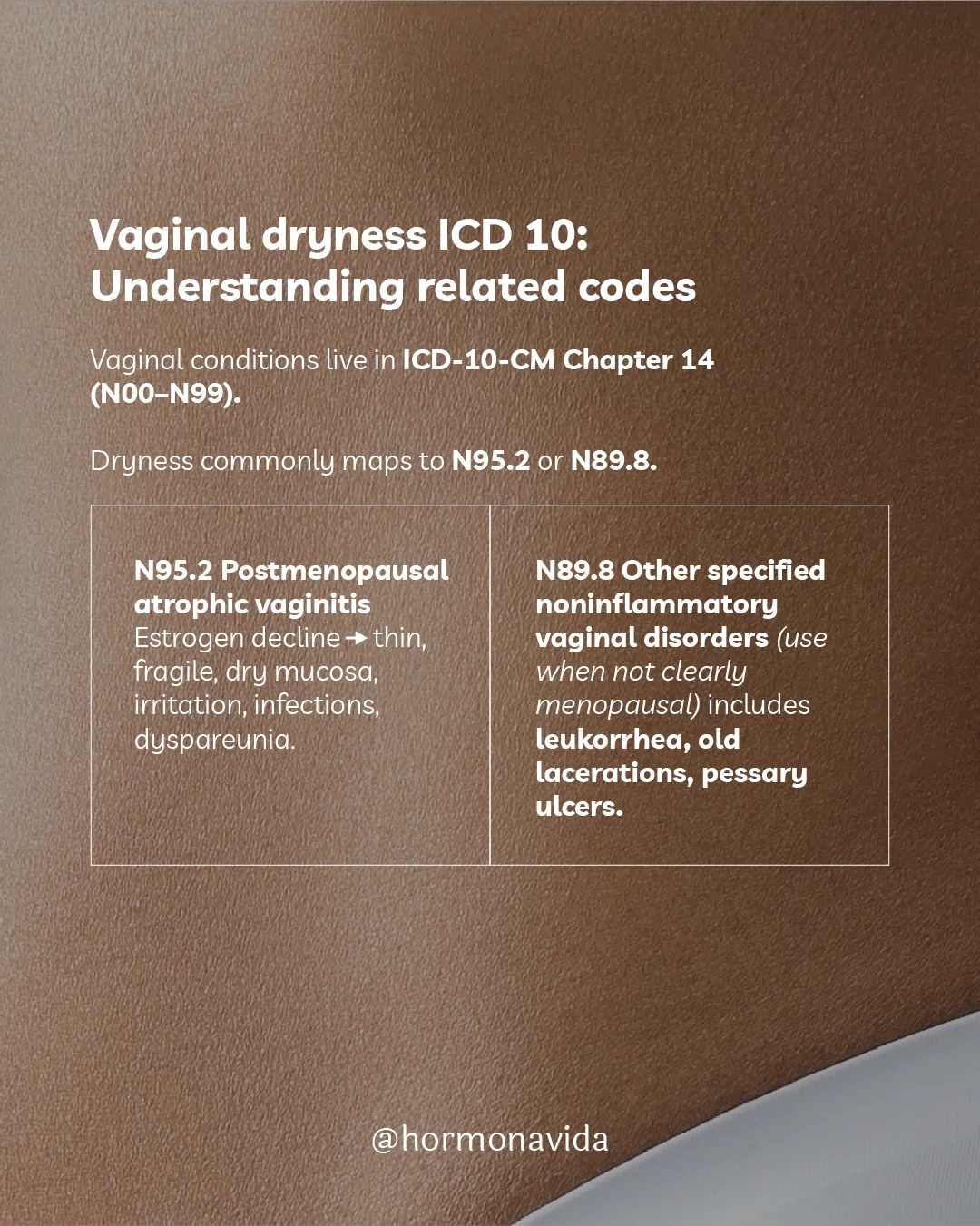Vaginal dryness ICD 10: understanding related codes
Vaginal dryness is common in midlife and after menopause. It can cause burning, discomfort, and pain with sex. Accurate coding matters.
It connects the symptom to a specific diagnosis for reimbursement purposes. It also supports good documentation and continuity of care. This guide explains coding for vaginal dryness in the American ICD-10-CM version.
It is educational only and not personal billing advice.

Where vaginal dryness sits in ICD-10-CM
Vaginal conditions are grouped in Chapter 14. This chapter is called diseases of the genitourinary system and uses codes N00–N99. Within this chapter, several codes may link to dryness. The most important are N95.2 and N89.8.
N95.2 – Postmenopausal atrophic vaginitis
N95.2 is a billable specific ICD-10-CM code. It describes postmenopausal atrophic vaginitis.
In this condition, lower estrogen leads to thinning tissues. The vaginal mucosa becomes more fragile and dry. Women may notice irritation, recurrent infections, or pain with intercourse.
The 2026 ICD-10-CM diagnosis code entry for N95.2 notes its use for postmenopausal atrophic vaginitis. It confirms that N95.2 remains a diagnosis for reimbursement purposes in the current update.
The 2026 edition of ICD-10-CM lists N95.2 under menopausal and perimenopausal disorders. It appears in the section for female reproductive conditions. Many online references show a table such as: “2016 2017 2018 2019 2020 2021 2022 2023 2024 2025 2026 billable specific code female dx”
This simply shows that N95.2 has stayed valid across multiple years and is applicable to female patients.
N89.8 – Other specified noninflammatory disorders of vagina
Some women have dryness without clear menopausal atrophy. In certain situations, N89.8 may be used instead. N89.8 is defined as other specified noninflammatory disorders of vagina.
It includes problems like leukorrhea, old lacerations, or pessary ulcers. N89.8 also sits in Chapter 14 among vaginal disorders. Here, type 2 excludes notes help coders avoid conflicts with other conditions.
Always follow provider documentation and official ICD-10-CM coding rules. Coders should never assign a code based only on a symptom phrase.

Key details about effective dates and versions
In the United States, ICD-10-CM updates follow a regular cycle. The 2026 ICD-10-CM diagnosis code set became effective on October updates for the fiscal year. For N95.2, one reference states that the code is valid from October 1 2025 through September 30 2026.
This applies to HIPAA-covered claims in the U.S. These dates apply to the American ICD-10-CM version only. Other countries use international versions of ICD-10 maintained by the WHO.
So, code details can differ between countries and regions. Always confirm which code set your organization uses.
How annotations and back references support correct coding
Online code tools often display extra guidance. These notes are applicable to annotations rather than the core code text.
Headings like “Applicable To” or “Includes” clarify common clinical scenarios. They help show when a diagnosis is applicable to female patients with dryness and other symptoms.
You may also see context annotation back references on code lookup sites. These annotation back references refer to related conditions or cross references.
In those tools, references refer to codes elsewhere in Chapter 14 or other chapters. They guide coders to more precise choices when symptoms overlap.
Used together, these notes and cross links support safer documentation. They encourage better alignment between clinical reality and billing records.
Practical tips for coding vaginal dryness
Keep these principles in mind when selecting a code:
- Start with the provider’s diagnosis, not just “vaginal dryness.”
- If dryness is clearly postmenopausal with atrophic changes, N95.2 is often appropriate.
- If the clinician documents another specified noninflammatory vaginal condition, consider N89.8.
- Check Chapter 14 notes, including Excludes and type 2 excludes entries.
- Confirm that codes used are current for the claim year.
Remember that coding for vaginal dryness supports more than payment. Accurate codes help track menopause care quality and research trends.
Supportive care at Hormona Vida
At Hormona Vida, we care about both codes and people. Vaginal dryness can affect comfort, intimacy, and self-confidence.
Our team uses evidence-based approaches. These may include lifestyle changes, local therapies, or personalized hormone strategies when appropriate.
If dryness affects your daily life, please seek medical advice. A clinician can offer a clear diagnosis and treatment plan tailored to you.
FAQs about vaginal dryness ICD-10-CM
What is the main vaginal dryness ICD 10 code?
The main code linked to postmenopausal dryness is N95.2. It describes postmenopausal atrophic vaginitis in ICD-10-CM.
Is N95.2 a billable specific ICD-10-CM code?
Yes. N95.2 is listed as a billable specific ICD-10-CM code for postmenopausal atrophic vaginitis.
How does the 2026 edition of ICD-10-CM affect coding?
The 2026 edition of ICD-10-CM updates descriptions and effective dates. However, N95.2 remains valid for postmenopausal atrophic vaginitis.
Do international versions of ICD-10 use the same codes?
Many countries use similar base codes. Still, international versions of ICD-10 may differ in notes and rules.
Where can I learn more about ICD-10-CM coding rules?
Official ICD-10-CM coding rules are published by CMS and NCHS. They include general and chapter-specific guidance for the genitourinary system.
References
- Centers for Medicare & Medicaid Services. (2024). ICD-10-CM official guidelines for coding and reporting, FY 2025.
- ICD10Data.com. (2025). 2026 ICD-10-CM diagnosis code N95.2: Postmenopausal atrophic vaginitis.
- AAPC. (n.d.). N89.8 – Other specified noninflammatory disorders of vagina.
- World Health Organization. (2019). ICD-10: International statistical classification of diseases and related health problems (10th rev.).
- Cao, T., et al. (2024). Toward reliable symptom coding in electronic health records. Journal of Biomedical Informatics, 154, 104722.




